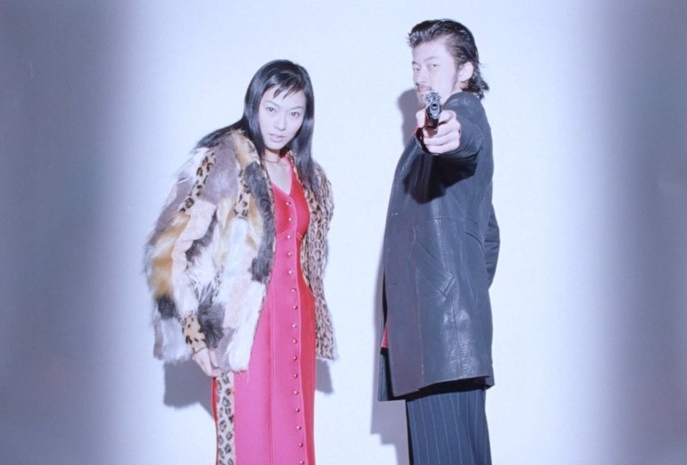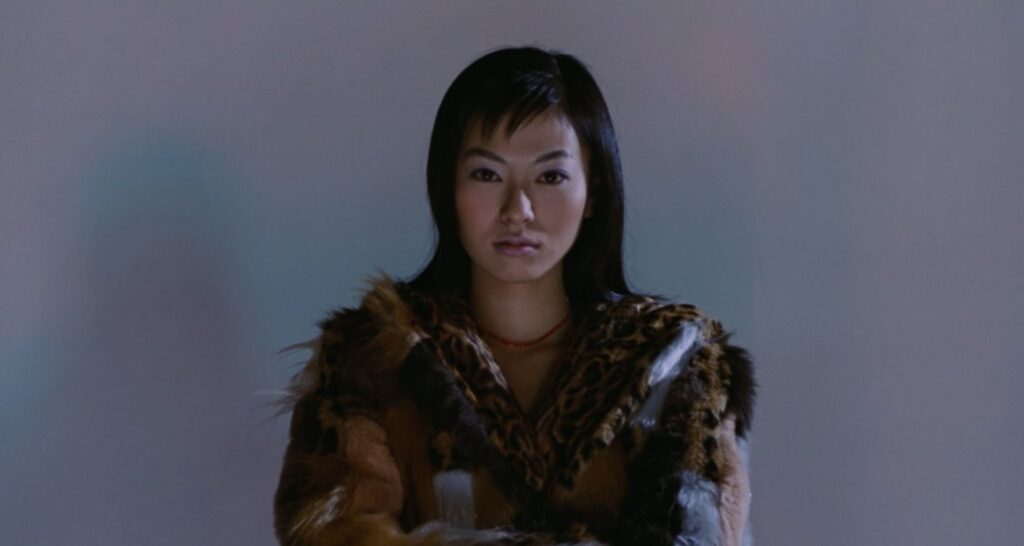
by Jeremy Clarke.

Deriving its odd title from a literal translation of the leads’ surnames, Katsuhito Ishii’s highly original gangster movie from 1998 is based on a familiar plot: a man runs off with the mob’s money, and a lady companion. Or, as pioneering French New Wave director Jean-Luc Godard once put it: all you need to make a movie is a girl and a gun.
Shark Skin Man and Peach Hip Girl has much the same strengths as Godard when he’s on form. Ishii demonstrates a similar flair for taking actors or actresses and having them do what they do on camera so that it’s completely absorbing to watch: look no further than the extraordinary title sequence which starts about five minutes in and consists of little more than names and images of all the major cast members against a white background with overlaid black line animation images. These resemble less the familiar style of anime and more that of comic artist Jamie Hewlett (Tank Girl, 1988-95), accompanied by a high octane, two-minute, soundtrack burst of punk thrash overlaid with a frenetic guitar solo. Or the sequence about two-thirds through the film where Tadanobu Asano keeps appearing from behind changing room curtains in a series of outlandish, jarring outfits until he picks the perfect one, a sharkskin suit and red shirt, not unlike the sequence of Peter Falk trying on a series of hats in Wim Wenders’ Wings of Desire (1987).

First-time director Ishii also demonstrates a gift for rendering mundane conversations compelling. Gangsters in a car discuss various formative experiences, mostly relating to drugs, whilst waiting for someone, in a scene not unlike the discussion that opens Reservoir Dogs (1992). For those wanting to push the Tarantino connection, as Jonathan Clements noted in his overview in Manga Max #7 some 25 years ago, Ishii’s adaptation of Minetaro Mochizuki’s 1993 manga filters its plot through the structure of Pulp Fiction (1994), more or less opening and closing on a robbery. It also has shades of the Tarantino-scripted True Romance (1993). The two directors struck up a friendship after Tarantino saw and liked Ishii’s film, later hiring him to do the animation on Kill Bill (2003).
The numerous couple-on the-run-movies made before True Romance include Arthur Penn’s Bonnie and Clyde (1967), Godard’s Pierrot Le Fou (1965), going back through Hollywood’s film noir period predated in Britain by Hitchcock’s The 39 Steps (1935). The latter similarly features a heroine who suddenly finds herself sharing a car with a male fugitive.
The obsession with the mundane seems equally indebted to the deadpan quality of Takeshi Kitano gangster movies. Ishii also elides various incidents (a car crash, a hotel car park car theft) by use of jump cuts, something Kitano’s films do a lot. Interviewed by Jim McLennan in Manga Max #7, Ishii unexpectedly cited the director’s baseball movie Boiling Point (1990) as the major influence from Kitano’s films.

A weird, deadpan, in-car conversation between a hotel employee and his taciturn, bespectacled colleague Toshiko Momojiri (Sie Kohinata) reveals that he’s quitting the hotel as of tomorrow which means that she, with her clean driving licence, will have to drive the little yellow car. This takes place against a wooded, mountainous landscape and a revelatory long shot of the hotel front desk with, from left to right, English language Cashier, Reception and Information signs above the centrally standing receptionist (male). “That guy’s weird,” says the speaker. “You should quit too when you’ve saved some money.”
Alas, her savings, as she discovers checking her passbook at a counter, have mysteriously been withdrawn. Meanwhile, the aforementioned weird guy – Michio (Youhachi Shimada) – answers the phone at the Hotel Symphonia reception desk to explain to her that her money isn’t gone, rather he’s reinvested it in a promising opportunity. She, understandably, is not happy. And even less happy when a man with a woollen hood with eyehole openings covering his head holds up to her view the payphone cable he has just cut.

Pulling out a revolver, he shoots a security guard, who writhes bleeding and incapacitated on the floor. He then uses a tape recorder or similar device to repeatedly play a “money please” and similar messages to horrified counter staff. There’s a clever, visual double-payoff, half of which is reserved ‘til towards the end of the film and half of which is kept until just before the end credits roll. It’s a curious ending which seems to work better on subsequent viewings of the film.
As suggested by those opening titles, Ishii delights in creating serial, bizarre characters with his cast. Mr. Tanuki (Ittoku Kishibe) sits in the back seat of a car playing with ballistically weighted knives discussing his enthusiasm for enamel posters while his driver Sorimachi (Koh Takasugi) tries desperately not to upset him by saying the wrong thing. The naked Samehada (Tadanobu Asano) indulges in a spot of group sex with two equally naked girls, while a white-haired man in a crimson-walled room that looks like something out of David Lynch (think Blue Velvet or Twin Peaks) and which turns out to be the lobby of the Hotel Symphonia, lights a cigarette with a lighter for a glamorous woman (Kimie Shingyouji) in a fur coat.

When McLennan quizzed Ishii as to whether Lynch’s Wild at Heart (yet another couple on the run movie, this one from 1990) was an influence, Ishii was delighted that someone had finally noticed. The director also cited Lynch’s use of sound, so it’s safe to assume he’s an admirer of the late Alan Splet who sound designed Lynch’s features from Eraserhead (1977) to Blue Velvet (1984).
The disparate elements and the plot strands they represent literally run into one another when Toshiko, driving to the post office on a road through the woodlands, crashes into a car load of gangsters pursuing Samehada as he flees on foot in socks, shoes and underpants. Now he’s driving the beaten-up yellow car with Toshiko unconscious in the passenger seat, her spectacles slipped down her nose in anticipation of her makeover to come, as he fields phone calls from her ‘uncle’, the weird hotel manager. Her makeover finally arrives much later on when the couple visit Samehada’s fixer Shiota (Hisaji Yamano) who memorably transforms her from submissive hotel employee into fur-clad bombshell.

Coming after them, following an astonishing shoot out with Toshiko in a lavatory, gangsters attempting entry from the building and Samehada firing at them from outside the lavatory window, is Mitsuru (Shingo Tsurumi), the white-clad son of the boss, given to telling his men they smell and using that same sense to track down his quarry with his nose close to the ground.
The weird hotel manager, meanwhile, later to be revealed as a sexual predator with designs on Toshiko, sends loopy killer Yamada (Tatsuya Gashuin, aka Akira Wakato), to get Toshiko back. Yamada is something of a surveillance expert, listening in on the gangsters’ phone conversations as they start to suspect the hotel girl of being Samehada’s accomplice, and he laughs at the prospect in a deranged manner. Gashuin steals the film, driving around in a little car with a radio ham aerial affixed to its roof, and falling head-over-heels for Samehada after failing to shoot him in a restroom cubicle.

A special mention should also go to Kitano regular Susumu Terajima, whose character Sawada, one of the gangsters, kidnaps the girl from Shiota’s place while Samehada is away getting the money to pay for her makeover. He proves intensely watchable throughout, and Ishii rewards him with a bizarre sequence towards the end entitled Sawada and God. Sitting in his car, in the woodlands, he explains to the bewildered Toshiko, “They sat me in a chair. I heard a voice. Give them both a chance. It was God. At least, that’s what I thought it was. Do you believe in God?”
Shark Skin Man and Peach Hip Girl is available as part of Katsuhito Ishii Collection, a three-disc, six-title, Region B, Blu-ray set from Third Window Films. Jeremy Clarke’s website is jeremycprocessing.com





